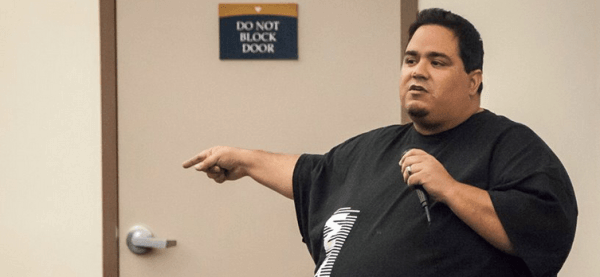 Telling better stories takes practice
Telling better stories takes practice
I tell a lot of stories. Pretty much every presentation I give starts with one, had many throughout, and ends with one. So people will often ask for tips on how to tell a better story – and today I decided to share a few.
1. Start with the Punchline
“You know how to tell if your new hire isn't going to work out? They ask you if you guys do mandatory drug testing.”
This works because it immediately grabs people's attention. It also gets you that immediate laugh that pulls in your audience and lets them know they ought to listen to the rest.
2. Ask a Question
“Have you ever hired someone, only to find out they were the wrong candidate?”
Sometimes the easiest way to engage an audience is to ask them a question. They hear the change in intonation at the end of your line, and they look up. They don't know if you're going to call on them. So they're all looking up, eyes on you and ears open. That's a great time to kick into a story.
3. Start in the middle
“So there I was, on hold while the person on the other end was looking to see if a Jonathan Green had graduated with a degree in Computer Science sometime around 1995.”
When I start a story in the middle, three things happen immediately. First, people wonder if they have already missed something – so they're focused and intent in their listening. Second, they want to know what happened before that. It's clear the beginning of the story is missing. And they want it – so watch as they try to ask you for more. That's a great sign that you've engaged them.
4. Dig into the (right) details
“So this guy walks into our office and he's sweating. I don't mean a little sweat. I'm talking about so much sweat that it looked like he'd walked the stairs to our office – on the 15th floor. His sweat beads were sweating – that's the level of sweat I'm talking about here.”
Details, at least the right ones, can be very funny – and can help you make your point. But too many details – or more importantly, the wrong ones – can kill stories. You want to keep them short. So focus!
5. Pulling it all together (and editing)
“I should have known. Let me ask you this – what's the last question you expect from your new hire? I'm talking the keepers. The good ones. Is it this one: ‘So do you guys do mandatory drug testing?'
“Now after a week, I set up a meeting to talk about Jonathan's performance. But he never showed – because his wife was in the hospital. But when I couldn't send her flowers, because no hospital had a patient named Green, I started to get suspicious.
“So I called UCSD to verify his degree. And as I sat on that call, waiting for the operator to validate that Jonathan Green had graduated in Computer Science somewhere around 1995, I started to get that feeling. That pit in my stomach.
“No, they couldn't find him. No, not in CS. No, not around 1995. No – they had never, in their entire history, ever had a Jonathan Green enrolled there.
“To this day I don't know who I hired. Or who I fired. But I do know one thing: it was a costly week.”
You'll notice in the story above that it's missing some detail – like the sweating component from earlier. But here's the thing: It didn't fit. It distracted. So it was removed.
That's what editing is – taking away everything that gets in the way and distracts.
So now…
Now you know some of my techniques for telling better stories. Now it's your turn!
